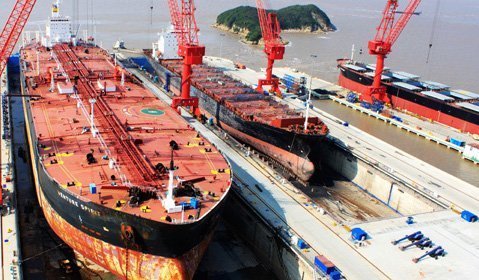Does permanent excess shipyard capacity presage a change in shipping cycles?

There’s an argument that too many available drydocks are making profits for owners short-lived. Not everyone is convinced with this theory however.
When interviewed by Maritime CEO in July, Dr Adam Kent, director of UK-based markets forecaster Maritime Strategies International (MSI), posited that the state of global shipbuilding has changed ship cycles forever, a contentious point of view that has sparked plenty of debate with leading names in the industry.
Even if yards are wound down or are mothballed the general infrastructure tends to remain in place, Kent suggested. The consequence to shipping, Kent maintains, is that the moment any single sector shows sustained improvement owners will be able to place orders at these underemployed shipyards, which will be hungry for new contracts, and these orders could easily be delivered in relatively short window, therefore curtailing any sustained market improvement.
“This paves the way for shipping market cycles to become shorter with lower peaks, as shipyard capacity no longer presents a limiting factor to timely provision of new supply,” Kent predicted.
Shipyard excess capacity is extraordinary in scale, says one of the world’s best known shipping analysts. Dr Martin Stopford, president of Clarksons Research, tells Maritime CEO: “Shipbuilding output of around 103m dwt in 2016 is at least 30% above the underlying demand for new ships.”
With China’s imports hardly growing; the world economy in a trough; and the offshore market in deep trouble, Stopford says current output could only be sustained by “heroic price cutting”.
“Cutting capacity makes sense,” he reckons, “but with the market split 37% China, 35% South Korea and 19% Japan it’s a game of chicken for who cuts first and most.”
“Don’t rule out some big price cuts,” Stopford says.
Esben Poulsson, the new chairman of the International Chamber of Shipping (ICS), believes excess shipbuilding capacity will not last forever, but that the shipping cycles of previous decades are gone forever.
“Cycles as we once knew them are probably a thing of the past,” he says, “and what we will see more of is shorter and sharper spikes and volatility as part of the new norm – against a background of rapid changes in technology and production/consumption patterns.”
The veteran shipowner goes on to claim: “If you add in the mixed and uneven prospects for the world economy, let alone the political situation, I think cycles – implying a degree of predictability – are a thing of the past.”
A cycle, by definition, should be symmetrical, points out Adrian Economakis, COO of online pricing platform VesselsValue, but what we are seeing recently with shipping is a non-symmetrical cycle with relatively longer down periods. “This is partly due to shipyard excess capacity – and the correlated low newbuilding order prices – but has also been effected by availability of capital and swings in market sentiment,” Economakis argues.
In simple terms, current excess shipyard capacity, combined with availability of capital and positive swings sentiment, has allowed large amounts of newbuildings to be ordered and delivered. This was particularly evident in 2013/2014 where an improvement in sentiment in the dry bulk sector led to a large amount of newbuilding orders in a very short period, which in turn, combined with lacklustre dry bulk demand, brought the market to its current historic lows.
Interestingly, there was a delayed cyclical effect in the recent buoyant tanker market. Tanker rates, until recently, have been very strong, but positive long term sentiment has been lacking. Values have stayed low and newbuilding ordering was limited.
“In other words,” states Economakis, “people were not expecting a sustained good market for tankers, so the earnings market stayed healthy for quite long and looks like a more conventional shipping cycle.”
However, with the recent downward trend in rates and continued fall in tanker values, we may be seeing another stage in a different cycle.
Tobias Koenig from Lexington Maritime believes overcapacity is the new normal for shipping.
“The markets are completely overbuilt and the need to scrap rate is around 50% of the fleet in most sectors,” he says, adding: “There will always be a reason for ordering new vessels, which will keep up overcapacity and the markets at fairly depressed levels.”
Like Kent, Koenig believes cycles will become shorter, albeit with less volatility.
Basil Karatzsas, a Greek ship finance expert based in New York, takes issue with Kent’s point of view.
“We all know from basic economics that excess capacity cannot remain the permanent market state; eventually some yards will have to shut down or eliminate some of the excess capacity,” he argues, suggesting that the contraction in yards will most keenly be felt in China.
“When there is effectively nil financing for the average shipowner, excess shipbuilding capacity has little material consequence,” Karatzsas maintains.
It’s not just shipyard size, it’s also their efficiency that shipowners need to take into account. Andrew Craig-Bennett, lead opinion writer for this magazine, observes that the manhours needed to build a handysize bulk carrier have been reduced by roughly three quarters during his lifetime.
“There is no practical constraint on shipbuilding capacity at all,” Craig-Bennett believes. “Modern shipyards,” he says, “can flex their own capacity by subcontracting fit out, subcontracting blocks and practically anything else.”
The only practical constraint on ship supply, Craig-Bennett observes, is the supply of main engines – the only large component of a modern ship that is hand-built by experts.
Shipping has yet to decipher just what is the new normal when it comes to shipping cycles – what is more clear however is that there are still far too many drydocks offering temptingly low newbuild prices.
This article first appeared in the just published latest issue of Maritime CEO magazine, which is being distributed this week at SMM in Hamburg. Splash readers can access the full magazine for free by clicking here.
